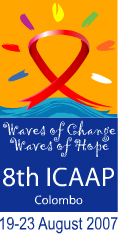The eighth International Congress on AIDS in Asia and the Pacific (ICAAP) takes place in Colombo, Sri Lanka from 19-23 August 2007. In the run up to the event, UNAIDS Deputy Executive Director, Deborah Landey and UNAIDS Regional Director for Asia and the Pacific, Prasada Rao, share their hopes and expectations for the conference that will host an expected 3,000 participants from some 60 countries throughout the region.
Visions for ICAAP8: Deborah Landey, UNAIDS Deputy Executive Director
Why is this conference important?
I think this conference is extremely important for the world and it’s very important for Asia. Many of the countries in Asia and the Pacific have relatively low prevalence and it’s an opportunity for us to take stock of what’s happening in the region and to come out with the goal of keeping Asia a low prevalence area of the world in terms of AIDS.
What are the focus areas for UNAIDS at this conference?
We are very concerned to emphasize the importance of leadership in responding to the epidemic at all levels—from governments to civil society, all players, actors must be involved.
It’s absolutely vital for countries to ‘know their epidemics’ – and by this we mean really having the most recent, developed data on what is going on with the epidemic in order to be able to use relatively scare resources effectively. In particular we are interested in understanding what we call the ‘drivers of the epidemic’ – the underlying systemic issues such as gender inequality, stigma and discrimination—and getting at these issues so that countries can make fundamental changes to get ahead of their epidemics.
We also want to emphasise that AIDS is going to be with us for a long time to come and therefore the long term agenda and all the issues we need to be thinking about for future generations are extremely important for us to consider here at this meeting.
What can this conference achieve?
If we can get a good analysis and understand what is happening in the region in terms of the epidemic so that we ‘know’ this epidemic in the region, what would be one outstanding outcome. Secondly – we want to know what is happening on the ground, what is working and what is not working? What are the lessons learned, where are we having successes and how can they be replicated? Establishing where the major challenges are will also be a goal.
Visions of Colombo: Prasada Rao, UNAIDS Asia Pacific Regional Director
What’s make the 8 th ICAAP an important meeting?
ICAAP has always been the rallying point for stakeholders such as civil society, people living with HIV, experts, national programme managers, UN partners and donors to focus world’s attention on the special problems of this large region which is home to the 60% of world population. AIDS need to be understood in this specific Asia Pacific context and ICAAP has always provided the best platform for it.
What are the most important issues that are going to be raised and discussed at ICAAP this year?
This ICAAP will specially address the changing AIDS scenario in the region. Recent revision of numbers in some countries has led to a great deal of public and media attention and this is an opportunity to look at the issues squarely and give clarifications. ICAAP will also look at some controversial issues of the moment, such as condom promotion, sex education at school and voluntary testing and counseling, within the Asian context. There will also be clear message about universal access to prevention, treatment, care and support and the need for increased provision of second generation antiretroviral drugs. The Conference also provides a platform for launching two important regional networks of men who have sex with men and sex workers.
What can you tell us about the AIDS epidemic in this region?
The AIDS epidemic in Asia and the Pacific is still increasing and there were approximately 1 million new infections in the last 2 years. Country like Papua New Guinea, Viet Nam Indonesia, Bangladesh and Pakistan are showing an increasing trends of new infections. However, there is good news in some countries. In addition to from Thailand and Cambodia we are seeing a reversal of the epidemic in the southern part of India which has a large population at risk. Infection has remained low in countries like Philippines and Sri Lanka despite large movement of workers for employment outside these countries.
How are countries of Asia and the Pacific scaling up towards universal access to HIV prevention, treatment, care and support?
The universal access agenda has given a great push to the effort of the countries in this region. Based on the political resolution on universal access adopted in UN in June 2007, countries in this region have initiated grassroots planning for setting ambitious target for prevention and treatment. Civil society groups have also enthusiastically participated in this exercise. Today, as many as 16 countries have set universal access targets and nine have prepared national strategic plans and identify resources for implementing them. Asia and the Pacific region can set high standard of achievement for the universal access process.
Links:
Listen to interview with UNAIDS Deputy Executive Director, Deborah Landey 8th International Congress on AIDS in Asia and the Pacific – official web site




